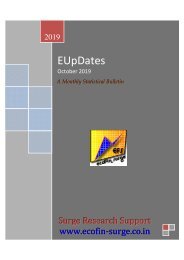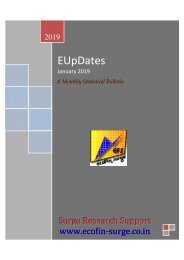EUpDates July 2021
A monthly statistical e-bulletin of the latest economic and financial market indicators. Quick Review of the Economy and over 30 Tables and some Charts.
A monthly statistical e-bulletin of the latest economic and financial market indicators. Quick Review of the Economy and over 30 Tables and some Charts.
Create successful ePaper yourself
Turn your PDF publications into a flip-book with our unique Google optimized e-Paper software.
INDIA’s IIP grew 29.3% yoy in May as compared to a 33.4% contraction in the same month a year ago. IIP fell
nearly 8% from April, making the impact of the state-wise lockdowns during the second wave of the
pandemic. The cumulative contraction during April-May 2021-22 was 68.8%, compared to de-growth of 45%
during the corresponding period a year ago. Manufacturing sector output, which accounts for more than 77%
of the entire index, saw a contraction of 9.5% from April, but a growth of 34.5% yoy in May as compared to a
contraction of 37.8% during the same month a year ago. Growth in electricity generation stood at 7.5% yoy in
May but witnessed a 7% month-on-month contraction, mainly due to low commercial sector demand.
Amongst the use-based categories, Consumer durables output witnessed the sharpest expansion of 98.2% in
May 2021 as compared to a contraction of 70.3% in May last year, but fell nearly 28% sequentially from April.
Capital goods output, which is reflective of the private sector investment scenario, grew 85.3% yoy. Consumer
durables and capital goods stood out as the worst affected sectors in May 2021, trailing the pre-Covid levels
by 41.2% and 36.9%, respectively.
Core sector output grew 8.9%yoy in June, this compares with a contraction of 12.4% in core sector output in
June 2020, and a 16.3% growth in May 2021. Of the eight sectors, all except crude oil registered positive
growth in June on a yearly basis. Steel and natural gas output grew at 25% and 20.6%, respectively, while
crude oil output contracted 1.8%. During April-June period this fiscal, the eight sectors grew by 25.3% against
a contraction of 23.8% in the same period last year.
MERCHANDISE EXPORTS from India grew 48.3% to $32.5 billion in June and were nearly 30% higher than
June 2019, while Services exports based on an estimation were $17.35 billion, 9.1% higher than a year ago
and about 1% lower than pre-COVID levels. MERCHANDISE IMPORTS rose by 98.31% to $41.87 billion,
leaving a TRADE DEFICIT of $9.37 billion as against a trade surplus of $0.79 billion in the same month last
year. Growth in export shipments across sectors such as petroleum products, gems and jewellery, and
chemicals, leather and marine goods were seen. Non-petroleum exports was at US$28.51 billion, registering a
growth of 41.8%over US$20.11 billion in June 2020 and growth of 27.33% over US$22.39 billion in June 2019.
Oil imports were US$10.68 billion, showing a positive growth of 114.92% compared to US$4.97 billion in June
2020 and negative growth of 4.72 compared to US$11.21 billion in June 2019. Major commodity groups of
export showing negative growth in June 2021 over June 2019include Tea (-25.08%), Leather and leather
manufactures (-21.0%), RMG of All Textiles (-18.76%), and Gems and Jewellery (-10.76%). Major commodity
groups of import showing negative growth in June 2021 over June 2019 include Silver (-97.16%), Gold (-
64.04%), Project Goods (-53.69%). Merchandise exports in April-June 2021 was US$95.36 billion, an increase
of 85.36% over US$51.44 billion in April-June 2020 and an increase of17.85% over US$80.91 billion in April-
June 2019. Merchandise imports in April-June 2021 was US$126.14 billion, an increase of 107.99% over
US$60.65 billion in April-June 2020 and a decrease of 3.05% over US$130.1 billion in April-June 2019.
India’s CURRENT ACCOUNT BALANCE recorded a surplus of 0.9% of GDP ($24 billion) in FY 2020-2021. The
shrinking trade deficit contributed in large measure to the current account balance turning to positive. In
2020-2021, however, India’s trade deficit shrank by 35% compared to the previous year [from (-)$157.5
billion to (-)$102.2 billion]. There was a sharp decline in the petroleum, oil and lubricants (POL) imports by
58%, from $130.6 billion in 2019-20 to $82.6 billion in 2020-21. While crude prices was 30% lower than what
it was in 2019-20, the steep decline in POL and capital goods imports can be traced to the slump in demand
and industrial production. India’s service exports did well and contributed to a surplus of $88.6 billion,
despite the slump in travel services. Software service exports continued to provide a safety net to the current
account, contributing $89.7 billion of surplus. Net invisible receipts were lower in FY21 due to an increase in
net outgo of overseas investment income payments and lower net private transfer receipts.
WPI annual inflation for All Commodities stayed high in June at 12.07% following the record high
of 12.94% in May. Low base effect of -1.81% in June 2020, and rise in prices of mineral oils viz
petrol, diesel ATF, etc, and manufactured products like basic metal, food products, chemical
products etc contributed to 0.75% higher inflation in June compared to May. Annual inflation in
the fuel & power basket eased to 32.83% during June, against 37.61% in May, inflation in food
articles too eased to 3.09% in June, from 4.31% May, while manufactured products, inflation
stood at 10.88% in June, against 10.83% in the previous month.
Consumer Price Index-based retail inflation for the month of June rose 6.26%, as food prices
hardened further, and transportation costs rose due to higher petrol and diesel prices. This is is
slightly lower than 6.30% for May, which was the highest in six months. Food inflation (CFPI) was
5.15% in June, compared with 5.01% in May, as food prices continued to remain inflated. Inflation
for the fuel & light sub-group rose 12.7% compared to 11.6% in May. Inflation in transport and
communication rose by 11.6%, while health costs continued to grow, registering an inflation of
8%, and the housing segment inched up 3.75%.
E-UpDates July 2021
3
Surge Research Support










